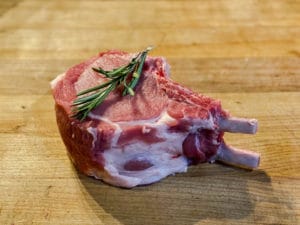In fall of 2021, Tony’s sent our meat team to Red Top Farms in Kearney, Missouri. Before Tony’s commits to a new major farm or source, we visit the farms and processing plants to see it for ourselves and get to know who is on the other end of our business. Owners, Tim, and Jamie Haas are both from multi-generational family farms in Wisconsin. They began Red Top / Premier Proteins from the basement of their home in 2005 and today they are bringing to us some of the most beautiful Berkshire Pork I have ever seen. Their pork, farms and processing facilities all passed our tests with flying colors.
Berkshire Pork Heritage Breed
Berkshire Pork has been called “The World’s Best Pork” by butchers and chefs around the world for centuries. Originally bred century’s ago in Berkshire County, England, with the original genetics carried on to this day. In Japan, it is referred to Kurobuta Pork which translates into “Black Pig” and I confirmed this with my lovely sister-in-law Sachiko who is native Japanese. In other words, the famous Japanese Kurobuta Pork is Berkshire Pork, and Kurobuta is known as the pork equivalent to Wagyu or Kobe Beef. It is amazing what good marketing can do. No matter what you call it, Berkshire is a favorite of Tony’s Meats for decades now.
Berkshire was 1st introduced to America in the mid 1800’s, and the genetics run true to this day. Berkshire is prized for it’s flavor, tenderness, and juiciness. Due to the higher PH levels in the meat, it is slightly redder than otherwise “white” (and dry) commodity pork. One of the many difference and perhaps most impactful is Berkshire has beautiful marbling deep in its muscle fibers, which gives you the juiciness and flavor you cannot get with grocery store commodity pork. You cannot always see as much of the marbling with the naked eye as you can with finely marbled beef, but I assure you, once cooked you will know it’s there.
The flavor and juiciness is a whole new experience in pork eating for most people, but no secret to the finest butchers chefs, and foodies around the globe. No more applesauce needed for dry pork. (Remember Peter Brady with his best Humphrey Bogart impression “Pork Chops and Applesauce…that’s swell”. For you old-timers, like me, it’s worth a quick chuckle:
The All-American Berkshire Pork Farms
Red Top Farms uses a series of small family farms located in the 4 corners area of Nebraska, Iowa, Kansas and Missouri. This is real American hog country without a doubt. Large corporate agricultural companies generally overlook most of these farms due to their small size, but it is these small family farms that form the foundation of America. The Berkshire genetics are cultivated on these farms according to the specifications set by Red Top Farms, and they undergo third-party audits to ensure compliance with various standards such as:
- Zero growth hormones
- Zero antibiotics
- Humanely treated livestock husbandry and transportation
- Animal age
- Berkshire genetics verified
- 100% vegetarian and nutritious feed
- Sustainable farmers land management practices
The Berkshire Pork Processing
OK, so none of us really like to talk or think of this stage of the meat supply chain, however it is the way of nature and the industry has modernized it in so many great ways. The processing plant is located centrally from most the farms that raise these hogs, as a result, creating a very quick transportation of the animals. It’s iportant to realize that the CO2 stun administers anesthesia to the animals, enabling the necessary processing to take place without inducing fear, anxiety, or pain. In fact, the facility undergoes USDA inspection and meets or exceeds all requirements of HACCP, CCP, traceability, temperatures, cleanliness, and safety. Indeed, a company I am proud to partner up with.
Preparing Berkshire Pork
I grew up in a generation where cooking pork to shoe leather was the accepted norm, hence, “Pork Chops and Apple Sauce.” People were so fearful of trichinosis that they destroyed their pork chops. Trichinosis and pork were primarily associated prior to the 1950s in America. Back then farmers actually “slopped the hogs”, which was a wet-concoction of scraps and leftovers, often times laden with bacteria.
Today through proper diets and nutrition, pigs are healthier than ever and trichinosis is no longer a threat. Accordingly to the CDC, trichinosis is rare, almost nonexistent, in America with a median rate of 15 cases per year (2008-2012) nationally, and over 50% of those cases were associated with eating under-cooked or raw bear meat or other wild game.
The USDA recommends cooking pork to 145 degrees F. With this in mind, I admit, I usually cook mine to slightly under 145, but while the meat sits and rests it rises to or above the 145 USDA recommended temperature. Once you try Berkshire Pork cooked properly you may perhaps for the 1st time in your life taste how amazing pork can be. Overall, Berkshire Pork is highly nutritious, high in protein, niacin, vitamins B6 and B12, selenium, iron and zinc name just to name a few. And, for that reason, in today’s high inflationary times, healthy and delicious pork is a great value. All things considered, stop by Tony’s and discover how great pork can be.
Tuscan Style Double-Cut Berkshire Pork Chops
Tuscan Herb Marinade:
- ½ cup Olive Oil
- 3 Tablespoons fresh Thyme…remove stems
- 2 Tablespoons fresh (Flat) Italian Parsley…chopped
- ½ teaspoon Tony’s Flaked Butchers Salt* or to taste
- ½ teaspoon Cracked Black Pepper
- 3 teaspoon fresh Lemon Zest
-Recipe good for 2 Double Chops…double recipe if cooking more than 2
*If table salt used, use less…
Cast Iron Method:
- Marinate chops 30-90 minutes…SAVE over ½ the marinade for topping you finished chops…
- Preheat oven to 375 degrees
- Sear chops in HOT cast iron grill-skillet (or heavy skillet)
- 90 seconds per side
- Can also grill on outdoor charcoal, smoker or gas grill.
- Place entire skillet immediately into pre-heated oven
- Roast 20 – 30 minutes…varies depending on thickness of chops
- Pull Chops at 140 degrees**
- Let chops sit about 5-10 minutes…they will rise in temperature
- Drizzle with more marinade and enjoy
- IMPORTANT…DO NOT OVERCOOK…145 will be perfect, moist, slightly pink, tender and juicy…The way pork should be…
**USDA recommends 145 degrees internal temperature for pork.
by Daniel J. Rossaci, CEO of Tony’s Market
Check out more pork recipes here.



